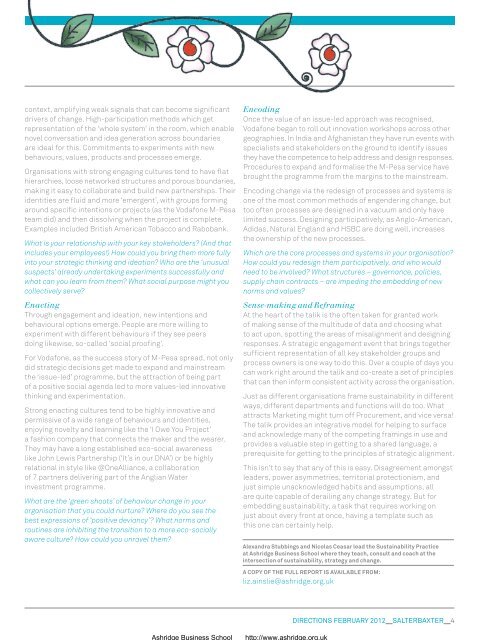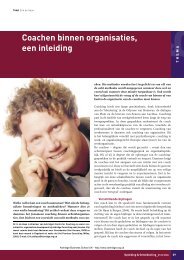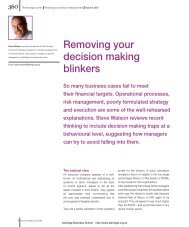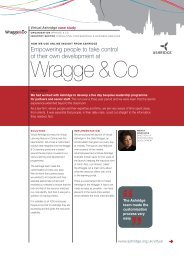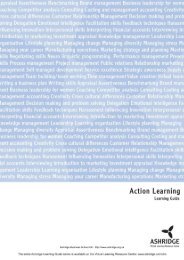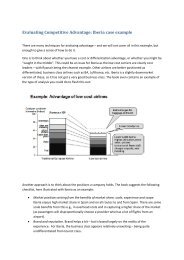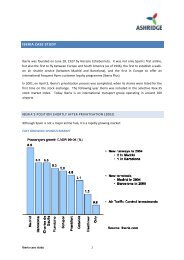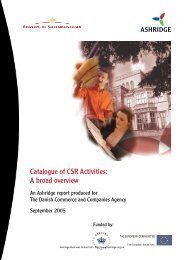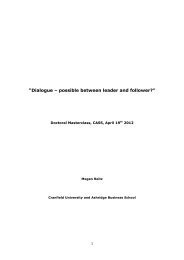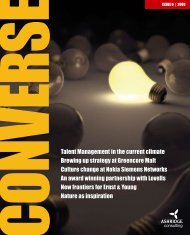Sustainability Forever? Embedding sustainability in your ... - Ashridge
Sustainability Forever? Embedding sustainability in your ... - Ashridge
Sustainability Forever? Embedding sustainability in your ... - Ashridge
You also want an ePaper? Increase the reach of your titles
YUMPU automatically turns print PDFs into web optimized ePapers that Google loves.
context, amplify<strong>in</strong>g weak signals that can become significant<br />
drivers of change. High-participation methods which get<br />
representation of the ‘whole system’ <strong>in</strong> the room, which enable<br />
novel conversation and idea generation across boundaries<br />
are ideal for this. commitments to experiments with new<br />
behaviours, values, products and processes emerge.<br />
organisations with strong engag<strong>in</strong>g cultures tend to have flat<br />
hierarchies, loose networked structures and porous boundaries,<br />
mak<strong>in</strong>g it easy to collaborate and build new partnerships. their<br />
identities are fluid and more ‘emergent’, with groups form<strong>in</strong>g<br />
around specific <strong>in</strong>tentions or projects (as the Vodafone M-Pesa<br />
team did) and then dissolv<strong>in</strong>g when the project is complete.<br />
Examples <strong>in</strong>cluded British American tobacco and Rabobank.<br />
What is <strong>your</strong> relationship with <strong>your</strong> key stakeholders? (And that<br />
<strong>in</strong>cludes <strong>your</strong> employees!) How could you br<strong>in</strong>g them more fully<br />
<strong>in</strong>to <strong>your</strong> strategic th<strong>in</strong>k<strong>in</strong>g and ideation? Who are the ‘unusual<br />
suspects’ already undertak<strong>in</strong>g experiments successfully and<br />
what can you learn from them? What social purpose might you<br />
collectively serve?<br />
Enact<strong>in</strong>g<br />
through engagement and ideation, new <strong>in</strong>tentions and<br />
behavioural options emerge. People are more will<strong>in</strong>g to<br />
experiment with different behaviours if they see peers<br />
do<strong>in</strong>g likewise, so-called ‘social proof<strong>in</strong>g’.<br />
For Vodafone, as the success story of M-Pesa spread, not only<br />
did strategic decisions get made to expand and ma<strong>in</strong>stream<br />
the ‘issue-led’ programme, but the attraction of be<strong>in</strong>g part<br />
of a positive social agenda led to more values-led <strong>in</strong>novative<br />
th<strong>in</strong>k<strong>in</strong>g and experimentation.<br />
Strong enact<strong>in</strong>g cultures tend to be highly <strong>in</strong>novative and<br />
permissive of a wide range of behaviours and identities,<br />
enjoy<strong>in</strong>g novelty and learn<strong>in</strong>g like the ‘I owe You Project’<br />
a fashion company that connects the maker and the wearer.<br />
they may have a long established eco-social awareness<br />
like John Lewis Partnership (‘It’s <strong>in</strong> our dnA’) or be highly<br />
relational <strong>in</strong> style like @oneAlliance, a collaboration<br />
of 7 partners deliver<strong>in</strong>g part of the Anglian Water<br />
<strong>in</strong>vestment programme.<br />
What are the ‘green shoots’ of behaviour change <strong>in</strong> <strong>your</strong><br />
organisation that you could nurture? Where do you see the<br />
best expressions of ‘positive deviancy’? What norms and<br />
rout<strong>in</strong>es are <strong>in</strong>hibit<strong>in</strong>g the transition to a more eco-socially<br />
aware culture? How could you unravel them?<br />
Encod<strong>in</strong>g<br />
once the value of an issue-led approach was recognised,<br />
Vodafone began to roll out <strong>in</strong>novation workshops across other<br />
geographies. In India and Afghanistan they have run events with<br />
specialists and stakeholders on the ground to identify issues<br />
they have the competence to help address and design responses.<br />
Procedures to expand and formalise the M-Pesa service have<br />
brought the programme from the marg<strong>in</strong>s to the ma<strong>in</strong>stream.<br />
Encod<strong>in</strong>g change via the redesign of processes and systems is<br />
one of the most common methods of engender<strong>in</strong>g change, but<br />
too often processes are designed <strong>in</strong> a vacuum and only have<br />
limited success. design<strong>in</strong>g participatively, as Anglo-American,<br />
Adidas, natural England and HSBc are do<strong>in</strong>g well, <strong>in</strong>creases<br />
the ownership of the new processes.<br />
Which are the core processes and systems <strong>in</strong> <strong>your</strong> organisation?<br />
How could you redesign them participatively, and who would<br />
need to be <strong>in</strong>volved? What structures – governance, policies,<br />
supply cha<strong>in</strong> contracts – are imped<strong>in</strong>g the embedd<strong>in</strong>g of new<br />
norms and values?<br />
Sense-mak<strong>in</strong>g and Refram<strong>in</strong>g<br />
At the heart of the talik is the often taken for granted work<br />
of mak<strong>in</strong>g sense of the multitude of data and choos<strong>in</strong>g what<br />
to act upon, spott<strong>in</strong>g the areas of misalignment and design<strong>in</strong>g<br />
responses. A strategic engagement event that br<strong>in</strong>gs together<br />
sufficient representation of all key stakeholder groups and<br />
process owners is one way to do this. over a couple of days you<br />
can work right around the talik and co-create a set of pr<strong>in</strong>ciples<br />
that can then <strong>in</strong>form consistent activity across the organisation.<br />
Just as different organisations frame <strong>susta<strong>in</strong>ability</strong> <strong>in</strong> different<br />
ways, different departments and functions will do too. What<br />
attracts Market<strong>in</strong>g might turn off Procurement, and vice versa!<br />
the talik provides an <strong>in</strong>tegrative model for help<strong>in</strong>g to surface<br />
and acknowledge many of the compet<strong>in</strong>g fram<strong>in</strong>gs <strong>in</strong> use and<br />
provides a valuable step <strong>in</strong> gett<strong>in</strong>g to a shared language, a<br />
prerequisite for gett<strong>in</strong>g to the pr<strong>in</strong>ciples of strategic alignment.<br />
this isn’t to say that any of this is easy. disagreement amongst<br />
leaders, power asymmetries, territorial protectionism, and<br />
just simple unacknowledged habits and assumptions, all<br />
are quite capable of derail<strong>in</strong>g any change strategy. But for<br />
embedd<strong>in</strong>g <strong>susta<strong>in</strong>ability</strong>, a task that requires work<strong>in</strong>g on<br />
just about every front at once, hav<strong>in</strong>g a template such as<br />
this one can certa<strong>in</strong>ly help.<br />
alexandra Stubb<strong>in</strong>gs and nicolas ceasar lead the <strong>Susta<strong>in</strong>ability</strong> Practice<br />
at ashridge Bus<strong>in</strong>ess School where they teach, consult and coach at the<br />
<strong>in</strong>tersection of <strong>susta<strong>in</strong>ability</strong>, strategy and change.<br />
a cOPy Of the full rePOrt iS availaBle frOm:<br />
liz.a<strong>in</strong>slie@ashridge.org.uk<br />
<strong>Ashridge</strong> Bus<strong>in</strong>ess School http://www.ashridge.org.uk<br />
DIRECTIONS FEBRUARY 2012 SAlTERBAxTER 4


